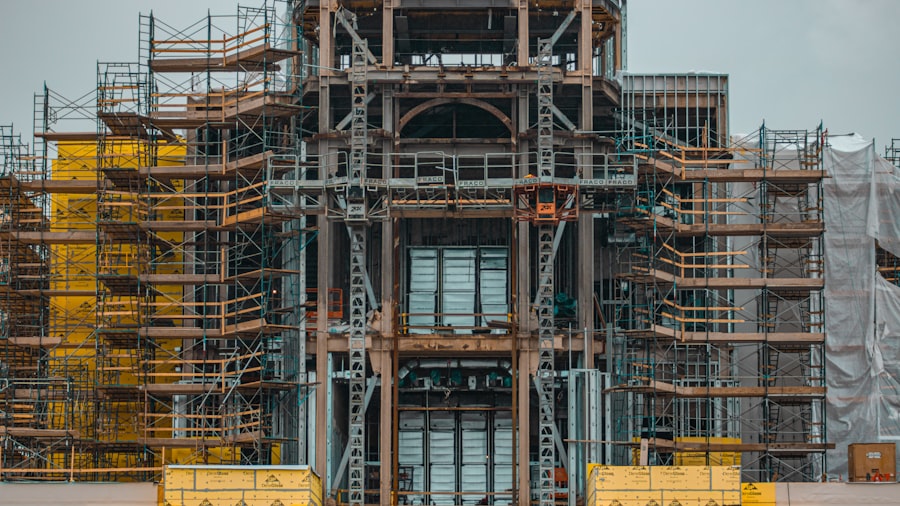In today’s digital age, having a strong online presence is crucial for any business, especially for builders and contractors. I’ve come to realize that a well-designed WordPress website serves as a powerful tool to showcase my work, attract new clients, and establish credibility in the industry. A website is often the first point of contact potential clients have with my business, and it’s essential that it reflects my professionalism and expertise.
By investing time and resources into creating a functional and visually appealing website, I can effectively communicate my brand’s values and services to a wider audience. Moreover, a builders WordPress website allows me to stand out in a competitive market.
With so many options available to consumers, having a unique online platform can make all the difference.
I can highlight my unique selling propositions, such as specialized services or innovative building techniques, which can help me attract the right clientele. Additionally, a well-structured website can improve my visibility on search engines, making it easier for potential clients to find me when they search for building services in their area. This not only increases my chances of gaining new clients but also enhances my overall brand recognition.
Table of Contents
ToggleKey Takeaways
- A builder’s WordPress website is crucial for showcasing previous projects and attracting new clients.
- Choosing the right theme and design is essential for creating a professional and visually appealing website.
- Showcasing a portfolio of previous projects helps to build credibility and trust with potential clients.
- Integrating contact forms and lead generation tools is important for capturing potential leads and inquiries.
- Highlighting services and specializations on the website helps to communicate the builder’s expertise and offerings.
Choosing the Right Theme and Design for Your Website
Industry-Specific Themes
I often spend time exploring various themes that cater specifically to builders and contractors, as these are tailored to meet the unique needs of my industry.
Responsiveness and Customization
In addition to aesthetics, I consider the responsiveness of the theme. With an increasing number of users accessing websites via mobile devices, it’s essential that my site looks great and functions well on all screen sizes. I’ve found that many WordPress themes offer responsive designs that automatically adjust to different devices, which is a feature I prioritize. Furthermore, I pay attention to customization options that allow me to incorporate my branding elements, such as colors and logos, ensuring that my website reflects my business identity.
Key Considerations
Ultimately, selecting the right theme and design for my WordPress website requires careful consideration of both form and function. By prioritizing responsiveness, customization, and industry-specific features, I can create a website that effectively represents my business and provides a positive user experience for my visitors.
Showcasing Your Portfolio and Previous Projects

One of the most effective ways to attract new clients is by showcasing my portfolio and previous projects on my website. I understand that potential clients want to see tangible evidence of my skills and expertise before making a decision. By creating a dedicated portfolio section, I can display high-quality images and detailed descriptions of my past work, highlighting the variety of projects I’ve completed.
This not only demonstrates my capabilities but also helps build trust with prospective clients. I also make it a point to categorize my projects based on different types of construction work, such as residential, commercial, or renovations. This organization allows visitors to easily navigate through my portfolio and find examples relevant to their specific needs.
Additionally, I include case studies that outline the challenges faced during each project and how I overcame them. This not only showcases my problem-solving skills but also provides potential clients with insight into my working process and dedication to quality.
Integrating Contact Forms and Lead Generation Tools
| Tool | Features | Benefits |
|---|---|---|
| Contact Form 7 | Customizable forms, spam filtering, file uploading | Easy integration, flexibility, spam protection |
| HubSpot | CRM integration, lead scoring, analytics | Centralized data, lead prioritization, insights |
| Gravity Forms | Advanced fields, conditional logic, third-party integrations | Complex form creation, tailored user experience, seamless connections |
To convert website visitors into potential clients, integrating contact forms and lead generation tools is essential. I’ve learned that having a simple yet effective contact form on my website encourages visitors to reach out for inquiries or quotes. I ensure that the form is easy to fill out and includes fields for essential information such as name, email address, phone number, and project details.
This streamlined approach makes it convenient for potential clients to get in touch with me without feeling overwhelmed. In addition to contact forms, I explore various lead generation tools that can enhance my website’s functionality. For instance, offering downloadable resources such as eBooks or guides related to home building or renovation can entice visitors to provide their contact information in exchange for valuable content.
This not only helps me build a mailing list but also positions me as an authority in the industry. By nurturing these leads through targeted email campaigns, I can keep potential clients engaged and informed about my services.
Highlighting Your Services and Specializations
Clearly outlining the services I offer is crucial for helping potential clients understand what I can do for them. On my website, I dedicate a section to highlight my services and specializations, ensuring that visitors can quickly grasp the range of solutions available. Whether it’s new home construction, remodeling, or commercial projects, I make sure to provide detailed descriptions of each service along with any unique aspects that set me apart from competitors.
I also emphasize any certifications or specialized training I have received in specific areas of construction. This not only adds credibility but also reassures potential clients that they are working with a knowledgeable professional. By showcasing my expertise in niche areas—such as sustainable building practices or smart home technology—I can attract clients who are specifically looking for those services.
This targeted approach helps me connect with the right audience and increases the likelihood of securing projects.
Incorporating Testimonials and Client Reviews

Incorporating testimonials and client reviews on my website has proven to be an effective strategy for building trust and credibility with potential clients. Positive feedback from previous clients serves as social proof of my skills and reliability as a builder. I make it a priority to collect testimonials after completing projects, asking satisfied clients if they would be willing to share their experiences on my website.
I strategically place these testimonials throughout my site, particularly on key pages such as the homepage and service descriptions. This ensures that visitors encounter positive reviews early in their browsing experience. Additionally, I consider including client photos alongside their testimonials to add a personal touch and further enhance authenticity.
By showcasing real experiences from real people, I can create a sense of trustworthiness that encourages potential clients to reach out.
Optimizing Your Website for Search Engines
Search engine optimization (SEO) is an essential aspect of ensuring that my website reaches its intended audience. I’ve learned that optimizing my site for search engines involves several key strategies, including keyword research, on-page optimization, and creating high-quality content. By identifying relevant keywords related to my services—such as “home builder,” “renovation contractor,” or “custom homes”—I can strategically incorporate them into my website’s content.
On-page optimization is another critical component of SEO that I focus on. This includes optimizing title tags, meta descriptions, and header tags to improve search engine visibility. Additionally, I ensure that my website loads quickly and is mobile-friendly, as these factors contribute to better search rankings.
By regularly updating my content with fresh information—such as blog posts or project updates—I can further enhance my site’s SEO performance and attract more organic traffic.
Utilizing High-Quality Images and Videos
Visual content plays a significant role in capturing the attention of visitors on my website. I understand that high-quality images and videos can effectively showcase my work and create an engaging user experience. When displaying projects in my portfolio, I prioritize using professional photographs that highlight the details and craftsmanship of each build.
These images not only make my work look appealing but also help potential clients envision what I can do for them. In addition to images, I consider incorporating videos into my website as well. A short video tour of completed projects or behind-the-scenes footage of the construction process can provide visitors with a more immersive experience.
Videos allow me to convey emotions and stories that static images may not capture fully. By utilizing both high-quality images and videos, I can create a visually stunning website that leaves a lasting impression on visitors.
Creating a Blog to Share Industry Insights and Updates
Establishing a blog on my WordPress website has become an invaluable tool for sharing industry insights and updates with my audience. Through regular blog posts, I can provide valuable information related to construction trends, tips for homeowners, or advice on choosing the right contractor. This not only positions me as an expert in the field but also helps build trust with potential clients who seek reliable information.
I’ve found that blogging also contributes positively to my website’s SEO efforts. By incorporating relevant keywords into my posts and sharing valuable content regularly, I can improve my search engine rankings while attracting more visitors to my site.
Additionally, blogging allows me to engage with my audience by encouraging comments and discussions on various topics related to construction.
This interaction fosters a sense of community around my brand and keeps potential clients coming back for more insights.
Implementing Social Media Integration
Integrating social media into my WordPress website has proven beneficial for expanding my online reach and engaging with potential clients. By adding social media buttons that link directly to my profiles—such as Facebook, Instagram, or LinkedIn—I make it easy for visitors to connect with me on various platforms. This cross-promotion allows me to share updates about ongoing projects or industry news while driving traffic back to my website.
I also consider embedding social media feeds directly onto my site, showcasing recent posts or client interactions in real-time. This dynamic content keeps my website fresh and encourages visitors to engage with me on social media platforms where they can see more of my work in action. By leveraging social media integration effectively, I can create a cohesive online presence that enhances brand visibility and fosters relationships with potential clients.
Monitoring and Analyzing Website Performance and User Engagement
To ensure that my website is performing optimally and meeting its goals, monitoring and analyzing its performance is essential. I utilize various analytics tools—such as Google Analytics—to track visitor behavior, page views, bounce rates, and conversion rates. By understanding how users interact with my site, I can identify areas for improvement and make data-driven decisions.
Regularly reviewing this data allows me to assess which pages are performing well and which may need adjustments or updates. For instance, if I notice that certain blog posts are attracting significant traffic while others are not resonating with visitors, I can refine my content strategy accordingly. Additionally, monitoring user engagement metrics helps me gauge how effectively I’m connecting with potential clients through calls-to-action or lead generation tools.
By continuously analyzing performance data, I can optimize my website over time to better serve both current and prospective clients. In conclusion, creating a builders WordPress website involves careful consideration of various elements—from design choices to content strategies—that collectively contribute to its success. By understanding the importance of an online presence and implementing best practices across different areas, I can effectively showcase my work while attracting new clients in an increasingly competitive market.
If you are looking to improve the SEO of your Builders WordPress Website, you may want to check out this article on Unlocking the Power of Keywords: Strategies for Successful SEO. This article provides valuable insights on how to effectively use keywords to boost your website’s search engine rankings. Additionally, if you want to maximize the performance of your WordPress website, you can also read this article on Maximizing WordPress Performance: Top Optimization Tips. And if you are in the recruitment industry, you may find this article on Recruitment WordPress Website helpful in creating a professional and effective website for your business.
FAQs
What is a Builders WordPress Website?
A Builders WordPress Website is a website built using the WordPress platform that is specifically designed for builders, contractors, and construction companies. It typically includes features and functionalities tailored to the needs of the construction industry.
What are the key features of a Builders WordPress Website?
Key features of a Builders WordPress Website may include project portfolio showcase, client testimonials, service offerings, contact forms, project galleries, team member profiles, and integration with construction-specific plugins for project management and scheduling.
Why should builders use WordPress for their website?
WordPress is a popular and user-friendly content management system that offers a wide range of themes and plugins specifically designed for builders and construction companies. It allows for easy customization, updates, and maintenance of the website without the need for advanced technical skills.
How can a Builders WordPress Website benefit a construction business?
A Builders WordPress Website can benefit a construction business by providing a professional online presence, showcasing past projects and client testimonials, generating leads through contact forms, and improving search engine visibility through SEO-friendly features.
What are some popular WordPress themes for builders and construction companies?
Some popular WordPress themes for builders and construction companies include Divi Builder, Construction Pro, BuildPress, Renovation, and StructurePress. These themes offer customizable layouts, project showcase features, and integration with construction-specific plugins.




